Howard Hawks was more of a “genre-hopper” as opposed to a director known for working in one specific type of movie.
He made screwball comedies (“Bringing Up Baby”, “His Girl Friday”), gangster and crime thrillers (“Scarface”, “ The Big Sleep”) and musicals (“A Song is Born”, “Gentlemen Prefer Blondes”).
However, to most John Wayne fans, Hawks is best known for the five movies they worked on together, one modern-day adventure movie and four classic JW cowboy films. We’re going to take a look at them in order of preference and, as with other directors Wayne worked with, no prize for guessing which one tops the list.
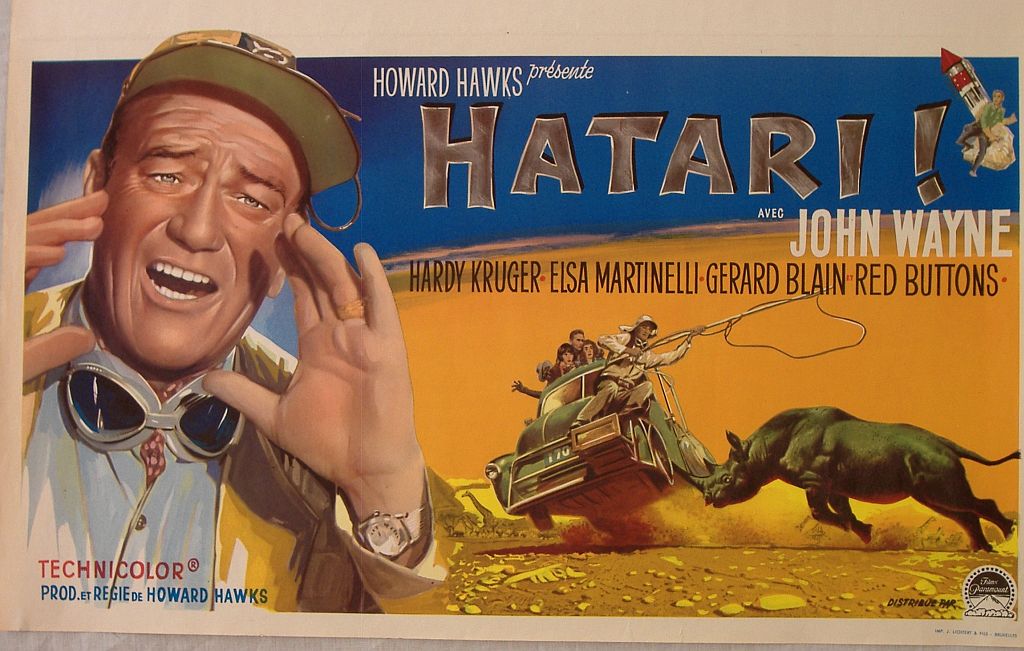 Hatari! (1962)
Hatari! (1962)
The only Wayne / Hawks non-Western, a romantic comedy drama concerning a group of wild-life hunters who capture animals for the zoo, providing the director with another opportunity to yet again explore the dynamics of a group of alpha males, with one or two women thrown in for good measure.
Just as in “Only Angels Only Have Wings”, in which Cary Grant played the leader of the group, it’s Wayne’s turn to take on that role as Sean Mercer, although in reality he’s just an observer and ring leader who looks on in bemusement at the antics of the other characters, played by Red Buttons, Bruce Cabot and Hardy Kruger, to name just a few.
Into this near all-male enclave saunters wild-life photographer Anna Maria D’Allesandro, otherwise known as Dallas, played by the delightful Elsa Martinelli.
Again, as in a lot of other Hawks films, most of the character’s sports nicknames such as Pockets, Chips, Brandy and The Indian. And just to reinforce the director’s penchant for constantly referencing his previous movies, there’s a reprise of the song “Whisky Leave Me Alone”, first heard in the Kirk Douglas vehicle “The Big Sky”.
Martinelli is the interloper in the group, as was Angie Dickinson in “Rio Bravo”, and Jean Arthur in “Only Angels Have Wings”.
Wayne’s character follows the same story trajectory as Dean Martin in “Rio Bravo”, having suffered a broken heart in a previous relationship.
Unable to articulate his feelings for Dallas, JW eventually woos her by using a group of baby elephants to prevent her leaving. Cue the cute Henry Mancini tune baby “Elephant Walk” (Mancini also wrote lyrics for the song which you can find on the internet).
The location shots were filmed in Tanganyika, which now forms part of Tanzania, and the animal capture sequences are quite impressive with Wayne strapped to the front of the jeep attempting to lasso any unfortunate creature that wanders across his path.
Chuck Roberson is uncredited as Wayne’s double for some of these scenes but you can definitely see at times that JW is actually handling his fair share of the stunts.
There’s a somewhat superfluous musical number a la “Rio Bravo” thrown in for good measure, with Buttons on harmonica and Martinelli appearing to be playing boogie-woogie piano for real. A couple of dance sequences also get thrown into the mix to show how hep to the scene these groovy cats are.
Despite the long running time of the film, it’s a pleasant way to pass two and half hours if you’re in the mood. The screenplay is by Leigh Brackett who delivers an affable easy-going storyline, very much as she did with “Rio Bravo”. “Hatari!” Isn’t exactly in the same league as that film, but it’s enjoyable just the same.
By the way, did you know Hatari is Swahili for danger? No, we didn’t either.
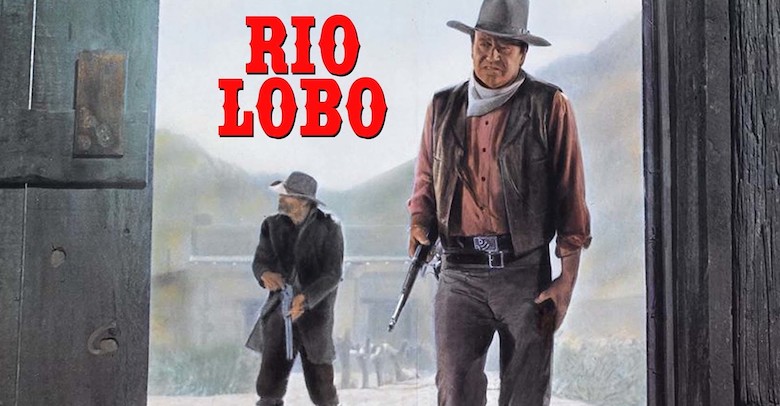 Rio Lobo (1970)
Rio Lobo (1970)
This is not only the last film John Wayne and Howard Hawks made together, it was also the last film Hawks would ever make, the director dying seven years later in 1977.
Just like “The Undefeated”, the film starts in Civil War territory, the opening sequence an extended train heist fashioned along the lines of “The War Wagon”.
This time, however, it’s Wayne and his army companions who are on the losing end, with Duke spending the rest of the movie, post-Civil War, hunting down the Union soldier who betrayed the whereabouts of the train to the Confederate Army, which was carrying a gold bullion payroll for the Union army.
JW finds himself surrounded by Western stalwarts such as Jim Davis, Hank Worden and Jack Elam. Elam makes quite an impression as Old Man Phillips, playing the role that was effectively essayed by Walter Brennan and Arthur Hunnicut in “Rio Bravo” and “El Dorado” respectively.
Jennifer O’Neill isn’t really in the same league as Angie Dickinson, or Charlene Holt for that matter when it comes to personifying the “Hawksian” woman, but she does look real purty.
The ever reliable Chuck Roberson is also present, playing what appears to be two separate characters. Guess he must have needed the money.
We also note the irony of the presence in the film of David Huddleston, playing the town dentist. A couple of years later he appeared as the mayor of Rock Ridge in “Blazing Saddles”, a film that we here at Mostly Westerns personally hold responsible for single-handedly sounding the final death knell for the Hollywood cowboy genre.
The script is actually quite good, which isn’t surprising seeing as it was co-written by Leigh Bracket. Also, carrying on from where “Chisum” left off, Wayne is left high and dry once more in the female relationship stakes, christened as ‘comfortable’ by one of his lady co-stars as his on-screen love life continues to bite the dust.
The similarities between “Rio Lobo” and “Rio Bravo”, and “El Dorado” for that matter, are too numerous to list here but the most obvious is the exchange of hostages at the end of the film, mirroring that of Dean Martin and Claude Akins in the earlier film.
Add to that the fact Walter Brennan must have left quite a lot of the dynamite hanging around that he used in “Rio Bravo” and it’s a wonder someone didn’t feel the need to file a plagiarism suit.
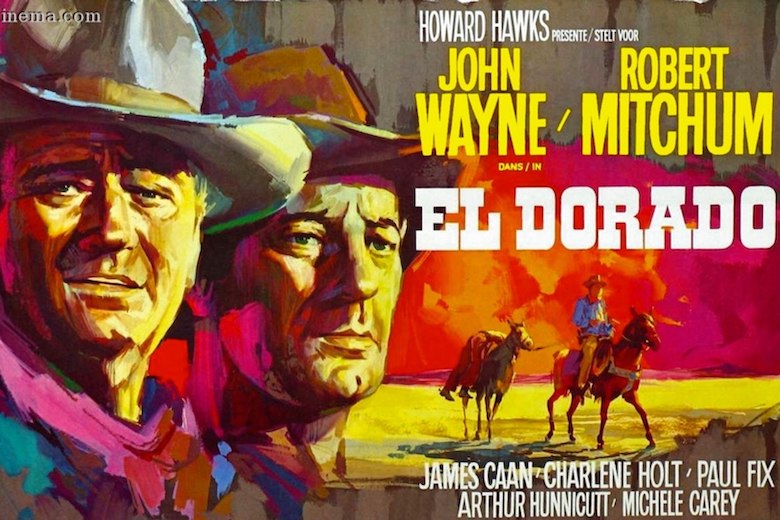 El Dorado (1966)
El Dorado (1966)
It should be noted that the song heard at the beginning of “El Dorado” was voted one of the best cowboy movie themes by the Western Writers of America Association. With music by Nelson Riddle and lyrics courtesy of John Gabriel, George Alexander sings it so seriously you almost believe everything he says is true which may just be the case seeing as the main character is based upon real-life cattle baron John Chisum.
“El Dorado” is virtually a remake of “Rio Bravo” with the script written (once more) by the ever-reliable Leigh Brackett, who later went on to co-write “The Empire Strikes Back”.
All you need to do is swap Robert Mitchum for Dean Martin, Arthur Hunnicutt for Walter Brennan and James Caan for Ricky Nelson, film it in Tucson, where “Rio Bravo” was filmed, then throw in the same director for good measure.
Only, on close viewing, it’s more of a companion piece, and of course, a starring vehicle for Wayne, who this time around plays gunfighter Cole Thornton, coming to the aid of yet another drunk, Sheriff J.P. Harrah, played by Mitchum.
Cole ends up being hamstrung almost from the beginning when he catches a bullet courtesy of the comely Michelle Carey, playing the daughter of the man Thornton had been hired to kill.
She shoots Cole after he blasts her younger brother, Luke, played by Johnny Crawford, that nice kid from TV’s “The Rifleman”, who shot at Cole first. Realising he’s just fired at John Wayne the kid does the decent thing and shoots himself dead before things get any worse.
The story is basically your typical “corrupt rancher wants to steal water rights from good rancher” kind of thing, so the film is really more concerned about character than it is anything else, and the actors play along accordingly.
Just as in “Rio Bravo”, Wayne is the moral centre of the film and to whom all the other characters defer to, one way or the other.
J.P. Harrah’s drinking habits force him to rely on his friend, Cole reappearing in town a few months later after initially having gone to seek medical advice on the bullet lodged near his spine. Upon hearing that a drunk J.P. is having to face a bunch of hired guns, and feeling beholden to the family of the boy he shot, Cole ignores any medical help on offer and rushes back to help J.P. out.
Along the way, Thornton is joined by another gunfighter, Mississippi, played by a fresh-faced James Caan, who is essentially a comedy relief version of Ricky Nelson’s Colorado.
It becomes clear that his ability with a gun is almost non-existent, although he makes up for it with a dazzling mastery of the knife that puts one in mind of James Coburn in “The Magnificent Seven”. He also quotes poetry as well and wears a silly-looking hat. It was obviously a part Caan felt he couldn’t refuse.
Charlene Holt plays Wayne’s romantic interest, Maudie, but lovely though she is, Ms. Holt cannot compete with the smouldering screen presence that was Angie Dickinson in “Rio Bravo”. She gives it a good try though.
Although the film is at times played mainly for laughs, especially the scene in which Mississippi treats Harrah to his own hangover cure, the overriding theme is one of ageing gunfighters trying to stay true to themselves even though their time is slowly fading into the past.
By the end of the film and despite besting hired gun Nelson McLeod, played by Christopher George, Thornton is barely able to limp down main street, still dogged as he is by the bullet lodged in his back, whilst Harrah hobbles along next to him with an injured leg.
Although one might read the last scene as a poignant reference to two actors now comfortably on their way towards late middle age, their onscreen partnership is a joy to behold, the both of them displaying the same kind of chemistry that Wayne and Dean Martin enjoyed in “Rio Bravo”.
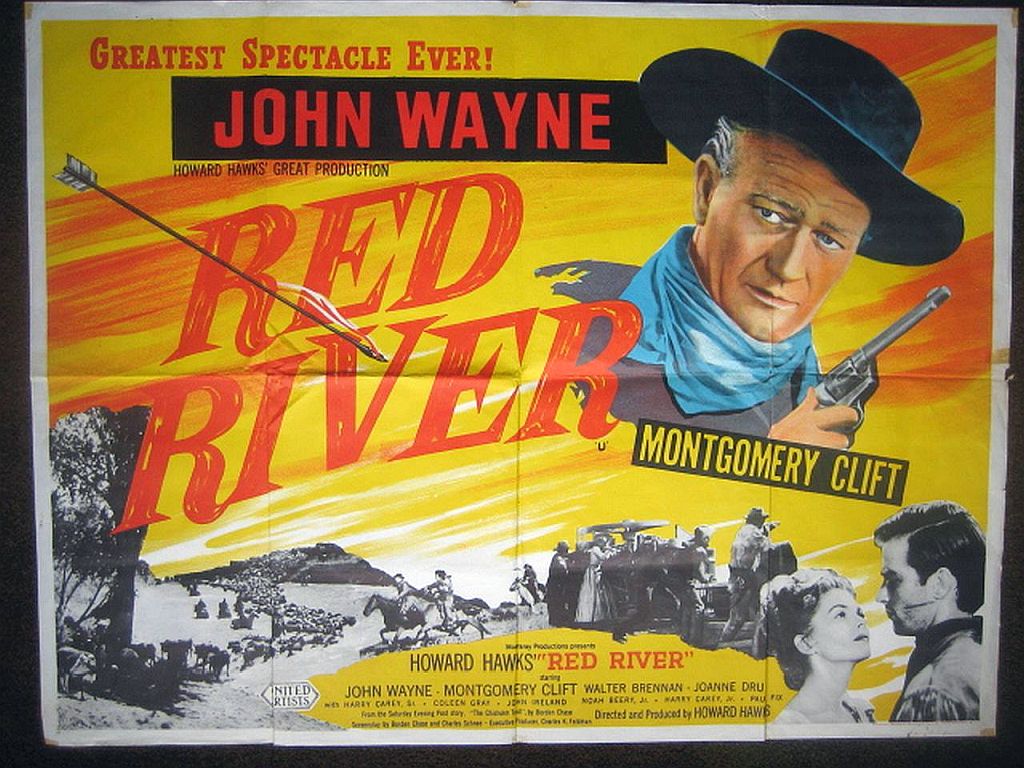 Red River (1948)
Red River (1948)
1948 was a good year for John Wayne and Westerns with audiences treated to the release in quick succession of “Red River”, “Fort Apache” and “3 Godfathers”, one Howard Hawks and two John Ford’s in 12 months.
In our humble opinion it never really got any better than that. If there is such a thing as a towering Duke performance, then “Red River” has it in spades.
Dimitri Tiomkin’s thunderous marching theme (which as every Wayne fan worth their salt knows serves as the melody for “My Rifle, Pony and Me” in “Rio Bravo”) immediately announces that we are in the company of a classic cowboy movie from the very first frame, and both Hawks and Wayne deliver the goods accordingly.
In his first Western for Hawks, JW plays the determined and stubborn Texas cattleman Tom Dunson, a character more in tune with the complexities of Ethan Edwards and Tom Doniphon than the straightforward and uncomplicated cowboys he had played previously.
This is the period in Wayne’s career when he starts to show real range in his acting abilities, famously prompting Ford to declare after seeing “Red River” that ‘I didn’t know the son-of-a-bitch could act’.
As the film progresses Dunson gets meaner and more unlikeable, and it’s a credit to Wayne that he was confident enough in his acting abilities to play such an aggressive and unpleasant individual as Dunson at this point in his career.
Montgomery Clift would not have been everyone’s first choice to co-star with Wayne as the orphaned Matt Garth who is taken under Dunson’s wing as a young boy.
Clift more than holds his own against Duke, however, eventually taking control of the cattle drive, whilst Wayne’s character becomes more and more embittered and ornery.
Wayne offers to sire children with Joanne Dru’s character, here playing pioneer Tess Millay, like a bull mating with a heffer. Not surprisingly she spurns Dunson’s offer and takes up with Matt Garth instead. At one stage Dru gets pinioned to a wagon by an arrow through the shoulder but doesn’t let on to anyone. A typically stoic Hawksian woman if ever there was one.
“Red River” is notable for the first time that both Harry Carey Senior and Junior appeared in the same film, although they don’t share any scenes together.
Walter Brennan as trail cook Groot here plays a younger version of Stumpy in the later “Rio Bravo”, although he looks exactly the same in both films.
Throw in John Ireland as gunfighter Cherry Valance, a cattle stampede, wagon train massacres and the like and you have the first real classic Western from director Howard Hawks.
The only false note in the film comes at the end, when a murderous Wayne goes gunning for Clift. They engage in a vicious fist fight which is then abruptly terminated by the intervention of Joanne Dru, who scolds the two men as though they were little boys.
It just feels as though no one could come up with a more convincing climax (apparently the original ending had to be changed as it bore too close a resemblance to a previous Hawks film, “The Outlaw”) but we have to admit in the scheme of things it doesn’t hurt the overall impact of the film in general and Wayne’s magnificent performance in particular.
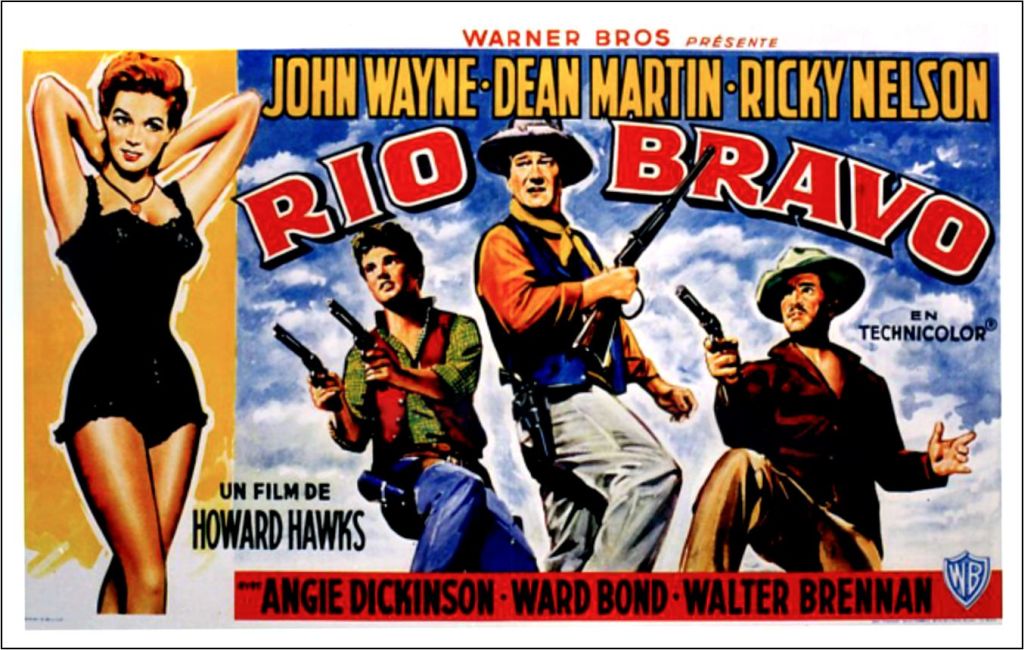 Rio Bravo (1959)
Rio Bravo (1959)
What can we say that hasn’t already been said about “Rio Bravo”? Whereas “The Searchers”, magnificent though it is, can be an intense film to watch in certain parts, it feels with “Rio Bravo” as though you’re dropping in to visit a group of old friends and you want to spend as much time with them as you possibly can.
The opening sequence to the movie plays almost like a silent movie with no real dialogue to speak of right up until the moment Chance arrests Joe Burdette.
The slow strumming of the guitar in the background as Dude slinks in through the rear of the saloon looking for his next drink. The first full shot of Duke as he tries to save Dude from further degradation, kicking a spittoon away as Dude goes to retrieve a silver dollar thrown into it by villain Joe Burdette, played by Claude Akins.
It’s a superior example of classic filmmaking from one of the few directors to match John Ford in both cinematic style and mastery of film language.
The film is a complete delight from the minute Dean Martin steps furtively through the back door of the saloon looking for a drink right through to the end when he and Walter Brennan walk down the street with Angie Dickinson’s tights wound around Brennan’s neck.
Despite a running time over 140 minutes, “Rio Bravo” has a very basic story. Chance (Wayne) and his compatriots Dude (Dean Martin), Stumpy (Walter Brennan) and Colorado (Ricky Nelson) are besieged by a group of outlaws wanting to get their friend out of jail before the marshal arrives.
That’s the whole plot in a nutshell but it’s the amazing array of aforementioned characters that beguile, on top of which you get a marvellous group of supporting actors as well to round things out including John Russell, Claude Akins and the ever-dependable Ward Bond.
 Let’s not forget Angie Dickinson as card-sharp Feathers either.
Let’s not forget Angie Dickinson as card-sharp Feathers either.
On the face of it the actress would, these days anyway, be considered a bit too young to play Wayne’s love interest, but the disparity in age between Chance and Feathers doesn’t really register that much, mainly due to the directing talent of Howard Hawks, who more often than not showcased strong female characters in his films.
After all, Lauren Bacall was only nineteen when she appeared opposite Humphrey Bogart in “To Have and Have Not”, yet carried herself convincingly in a rather more mature manner.
Hawks pulls off the same trick with Dickinson in “Rio Bravo”, the relationship between her and Wayne a cause for celebration rather than a questionable liaison between an older man and a younger woman.
There’s a palpable sexual chemistry between the two of them that you rarely witness in other Wayne films, so it comes as no surprise within the context of the story when they both end up in bed together midway through the film.
The action is sporadic, to say the least, but when it happens it happens quickly, after which the rhythm of the film settles once again into a slow, almost meandering examination of the dynamics of the group, a theme Hawks explores in quite a few of his other movies.
Our favourite moments are those that catch the audience off-guard: Chance suddenly kissing Stumpy on the forehead, the impromptu singing session in the jailhouse, Stumpy offering up an exaggerated, and what appears to be an unscripted impression of Chance, which prompts Dean Martin to almost dissolve in a fit of giggles, Dude clumping Chance with a piece of wood when denied the opportunity to retrieve a silver dollar from a spittoon, then Chance whacking Joe Burdette, in the same manner, a few moments later, although everyone knows damn well it’s Dude he’s mad at.
We could go on in a similar manner for quite a while but we know all of you are just as familiar with the film as we are so do yourselves a favour and go put the movie on right now and spend some time with those friends of ours. You won’t regret it.
So, no surprise that “Rio Bravo” takes the number one spot in our trawl through the films that John Wayne appeared in for director Howard Hawks. Next up we’ll be taking a look at JWs body of work with the four-times Academy Award winning director John Ford.

Must give THE WAR WAGON a rewatch. Can’t recall any train robbery in it.